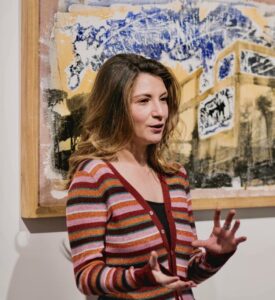Francesca Anfosso is an Italian gallerist. After a brief experience in publishing, eleven years ago she founded the 28 Piazza di Pietra Art Gallery in Rome, focusing on the promotion of painting and contemporary photography.

Art, whatever it takes – RomeArtProgram has made interviews with people involved in art, living in Italy, the USA and the UK, to know their feelings during these hard times.
-> Francesca Anfosso Interview:
RomeArtProgram: What is your definition of “art” today?
->Francesca Anfosso: “Art” is a broad and subjective concept, as far as I’m concerned art is a language, a medium to reflect reality and society, but also an opportunity to explore imaginary worlds and
express personal feelings.
RAP: Art is dynamic and regenerates itself… how does it change, and how did it change us?
-> Francesca: Art adapts and evolves over time, reflecting social, cultural, political and technological contemporary changes. I believe that contemporary art has contributed in recent years to the expansion of our perception of reality and to stimulate critical thinking by contributing to our growth, personal and collective.
RAP: When (and how) did you understand that art was becoming very important in your life?
-> Francesca: Since I was a child I had always been very attracted to all expressions of creativity, art
to literature to music, but it was only many years later, approaching professionals in the field, that I started thinking that it could become my job.
RAP: What role does art play today? What are the “great figures” who have recently changed it? Do you feel close to any of these figures?
-> Francesca: Art today serves several functions. It’s a space of freedom and, above all, a powerful means of expression. There are many artists, curators and gallerists who have influenced the contemporary art scene. Personally, I feel close to those who do the research work by going to find young talents and new “voices”.
RAP: Are there still traditional figures such as collectors, muses, mecenate and patrons, in today’s art and society interaction model?
-> Francesca: I think that compared to the past everything has become more pragmatic and less “romantic”, and that the patronage in the strict sense is now extinct. Collectors, fortunately for gallery owners, exist and are fundamental especially for the promotion and support of young artists.
RAP: How have the new technologies and media culture changed art today, improving or worsening it…? What do you feel are your biggest challenges?
-> Francesca: New technologies and media have had a significant impact on art, bringing both benefits and challenges. They have improved the accessibility and creative exploration in art, but have also led to a more intense commercialisation and homologations.
RAP: Art as a mirror of man, in this moment of emergency seems to be shattered …what do these fragments reflect now?… Shadow or light of the moment?
-> Francesca: I believe that art has always been a mirror of the complexity of the present, even in a moment of historical as the current one, reflecting its fragility and uncertainty.
RAP: Understanding, interpreting, and then possibly judging the work of art; which is the right path when we are in front of a piece of art?
-> Francesca: I think that is a personal and subjective process; as far as I am concerned, the first impact and the emotion that a work is able to arouse beyond its ‘framing’ and explanation is fundamental.
RAP: What is the real role of Academies and Art schools today? What can artists learn from these institutions today?
-> Francesca: I think they are a good starting point to build a good technical and theoretical base and to learn how to move in this difficult field; however, talent and artistic inclination are natural gifts.
RAP: Art too has undergone a complex process of globalization; can having an authentic and genuine style be an advantage or a drag for an artist?
-> Francesca: It’s always an advantage, and is fundamental.
RAP: How do Art Galleries and Museums position themselves today, and, in your opinion, how should they?
-> Francesca: Today’s scenery is much broader and more varied than in the past. Galleries and museums have the fundamental task of promoting and making artists and their work known to the general public, hopefully beyond national borders.
RAP: “Figurative” or “Abstract” ? Which of the two is better descriptive of the period we live in? Which one will have a better future?
-> Francesca: I personally consider the “figurative” to be the right style for an effective and universal storytelling.
RAP: Today we often speak of “emerging artists”; what advice based on your experience do you feel you can give to young artists?
-> Francesca: To remain true to oneself and put oneself to the test as much as possible without giving in to fashions or in the logic of the market.
RAP: Art as a lens for reading the present, can it modify the space and time we pass through? …will art save us?
-> Francesca: Art has the power to inspire, connect and bring awareness, offering reflective and critical spaces. However, salvation in a broad sense requires concrete actions by society. Art can be a catalyst, but its effectiveness depends on the collective commitment to translating the artistic inspiration into positive changes in reality.
@28piazzadipietra
28piazzadipietra.com
___________________
RomeArtProgram
#romeartprogram
Art-as-Power
.
